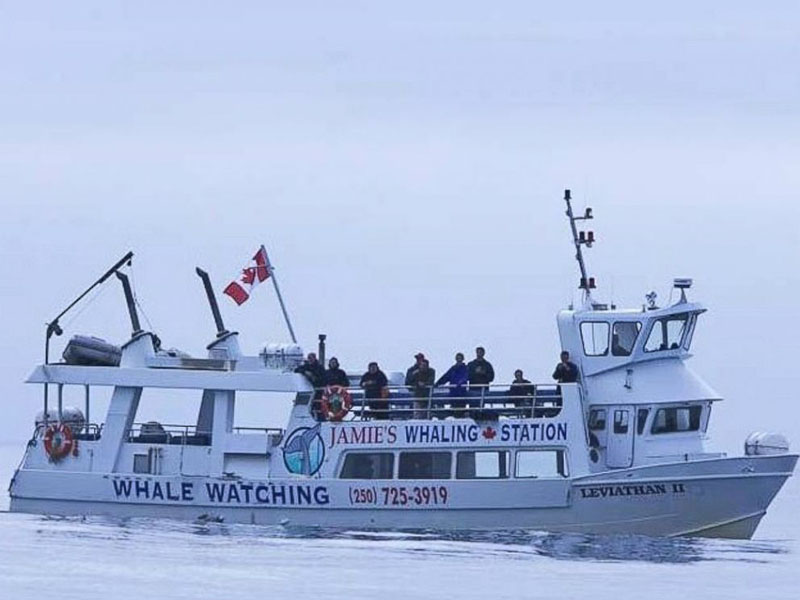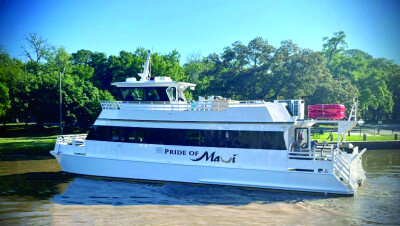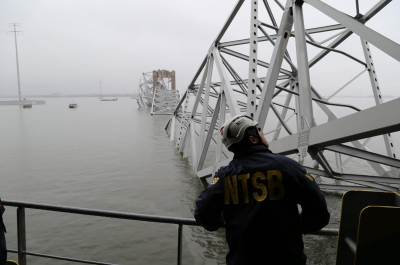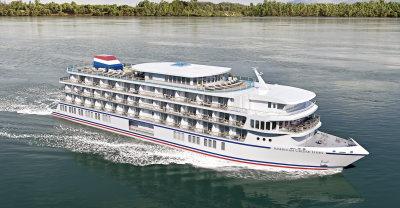A sudden huge breaking wave capsized the British Columbia wildlife tour boat Leviathan II in October 2015, too fast for the captain and crew to respond or passengers to don life jackets, the Canadian Transportation Safety Board (TSB) reported.
Six passengers, five Britons and an Australian citizen, died in the Oct. 25, 2015 accident, as the 65’ boat carried its passengers close to the Plover Reefs to observe sea lions, according to the TSB report.
Early stages of the investigation looked at any possible stability issues with the Leviathan II, built in 1981 as a crewboat for the forest products industry by Riv-Tow Industries, Vancouver, British Columbia. It was converted for whale watching in 1996 and an upper observation deck was added. Investigators reviewed past stability testing, and a post-accident analysis found no shortcomings.
The vessel operated by Jamie's Whaling Station & Adventure Centres, was approved for 46 passengers and carried 24 on the day of the accident off the west coast of Vancouver Island. As the captain approached Plover Reefs, the captain “visually assessed the sea conditions and checked for the presence of breaking waves, in particular at a spot south of the reef that the company's masters commonly used to determine prevailing conditions,” according to a narrative in the TSB report. “There were no signs of breaking waves or aerated water or foam in the surrounding area, other than on the edge of the reef itself.”
The vessel moved along the reef to give passengers views of the sea lions, and was about 300 yards off in 23’ of water heading north around 3 p.m. when the captain and a deckhand heard a noise and looked aft.
A breaking wave was coming down on the vessel’s starboard quarter, at a height above the flying bridge. The captain went for the throttles, intended to turn to port and take the wave on the stern, but it was too fast.
The Leviathan II broached and capsized, throwing passengers on the upper observation deck into the water. The crew was able to deploy a life raft, as passengers struggled in the rough water and others fought their way up and out of the flooding cabin.
The capsizing happened too fast for the crew to send a distress radio call, and the Leviathan II was not required to carry an emergency position indicating radio beacon (EPIRB), according to the report. After about 20 minutes in the water, the crew recovered a rocket flare that had floated clear of the vessel, and launched it.
The rocket was spotted by the crew of an Ahousaht First Nation fishing vessel that was hauling lines in the vicinity of Bartlett Island. Bringing in the line, the fishermen headed to the scene to see the capsized tour boat and people in the water. They called on VHF channel 68 for other vessels to assist. The Canadian coast guard lifeboat station at Tofino picked up the signal and launched a fast response boat.
At 3:46 p.m., the fishermen called the coast guard on VHF channel 16, and the communications center at Prince Rupert responded. Amid some confusion over the location of the accident, the officer in charge on the Tofino boat got on the radio and clarified it. The communications center then relayed the mayday at 3:53 p.m.
The Joint Rescue Center in Victoria dispatched two aircraft and four vessels to assist the rescue, and the Royal Canadian Mounted Police and several local boats also responded to the mayday.
“Twenty-one survivors were rescued and transferred to Tofino, where they were attended to by emergency health services. Some of the passengers suffered from hypothermia, ranging from mild to severe,” the report noted.
Based on its findings in the Leviathan II case, the TSB issued three recommendations for Transport Canada to require of commercial passenger vessel operators:
- Operators on the west coast of Vancouver Island should “identify those areas and conditions conducive to the formation of hazardous waves, and adopt practical strategies to reduce the likelihood of an encounter.”
- Passenger vessel operators throughout Canada “should be required to adopt explicit risk-management processes that identify hazards and then implement proactive strategies to reduce these risks. These risk management processes should also be accompanied by comprehensive guidelines so that vessel operators and TC inspectors can implement and oversee them effectively.”
- All passenger vessels operating beyond sheltered waters should carry EPIRBs or similar automatic distress beacons. The TSB cited its finding that it took 45 minutes after the capsizing for the coast guard to be alerted of the emergency.
Jamie Bray, the founder and owner of Jamie's Whaling Station, issued a video statement responding to the TSB's findings.
“Today we have heard from the Transportation Safety Board on the results of their investigation into the accident, and I can assure everyone that we will take their recommendations seriously. The TSB has said there are areas that we can improve on and we will," Bray said.
"Since the accident, we have been working with the industry to continue improving safety. We have put more life saving equipment on all our ships and continue to do extensive training with our crews and incorporate all that we have been able to learn from this tragic accident.
"Jamie’s Whaling Station is a company that bears my name. As the founder and president, I want to assure you that nothing is more important to me than the safety of our customers and crew.”
A transcript of the complete statement and a link to the video can be viewed on Jamie's Whaling Station's website.





